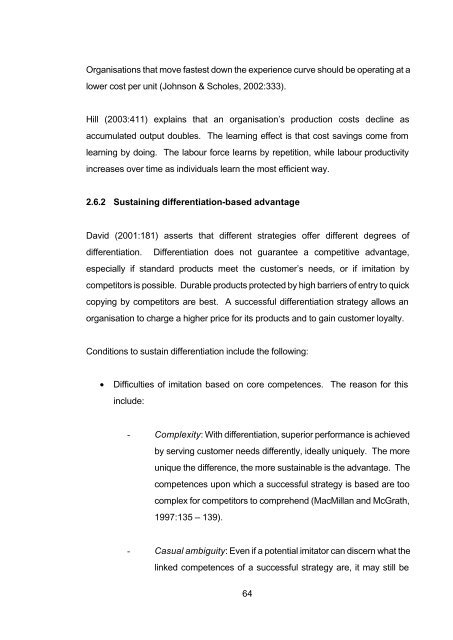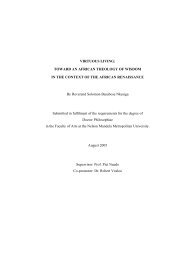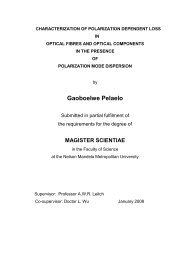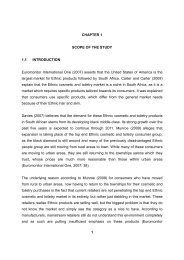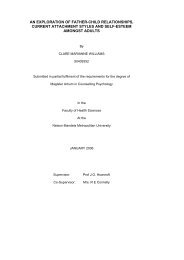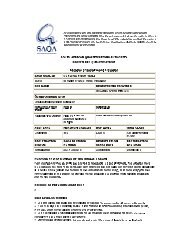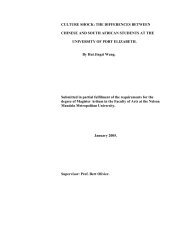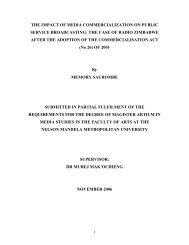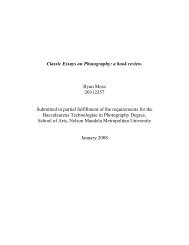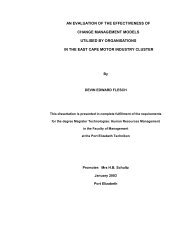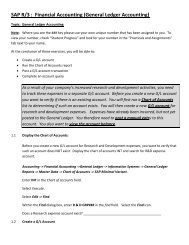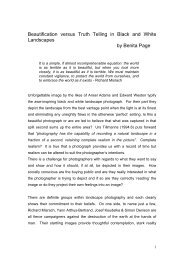- Page 1 and 2:
THE IDENTIFICATION OF FACTORS THAT
- Page 3 and 4:
ACKNOWLEDGEMENTSI hereby wish to ex
- Page 5 and 6:
protection, human resource developm
- Page 7 and 8:
2.3.4 Competitive rivalry 372.4 SOU
- Page 9 and 10:
4.3.3.1 Section one : Demographics
- Page 11 and 12:
Figure 2.1 Porter’s diamond 13Fig
- Page 14 and 15: LIST OF ANNEXURESPAGEAnnexure A Cov
- Page 16 and 17: Mandela Metropolitan Municipality (
- Page 18 and 19: activities at comparable cost but i
- Page 20 and 21: core competences of establishing de
- Page 22 and 23: Firms in every industry have some u
- Page 24 and 25: • A survey was carried out in the
- Page 26 and 27: surprise that the freight transport
- Page 28 and 29: Source: Hill (2002: 159)According t
- Page 30 and 31: attractiveness of a country as a pl
- Page 32 and 33: generalised factor would be a pool
- Page 34 and 35: The second determinant of Porter’
- Page 36 and 37: This is because firms compete globa
- Page 38 and 39: (c)Anticipatory buyer needsA countr
- Page 40 and 41: the service or product buyer needs.
- Page 42 and 43: arely a complete substitute, even i
- Page 44 and 45: firm’s strategy, structure and ri
- Page 46 and 47: Porter (1990:117) says domestic riv
- Page 48 and 49: means of identifying the forces whi
- Page 50 and 51: ased economies, and their trade pol
- Page 52 and 53: transport, it is frequently economi
- Page 54 and 55: for the purpose of this study.Figur
- Page 56 and 57: According to Strickland and Thompso
- Page 58 and 59: cost advantage. Successful cost lea
- Page 60 and 61: 2.5.4 Shifting input costs or avail
- Page 62 and 63: eduction is regarded as essential t
- Page 66 and 67: and Strebel and Porter has, however
- Page 68 and 69: options available to organisations.
- Page 70 and 71: 2.7.1.2 The hybrid strategy - route
- Page 72 and 73: Source : Slack et al (2001 :116)The
- Page 74 and 75: • Marketing-based approaches: Her
- Page 76 and 77: difficult if the organisation compe
- Page 78 and 79: For an efficient multimodal system,
- Page 80 and 81: good for all. It is anti-congestion
- Page 82 and 83: to another while in transit from or
- Page 84 and 85: also road movements, were performed
- Page 86 and 87: insurance rates for all parties.•
- Page 88 and 89: distributed to everyone involved or
- Page 90 and 91: subject to the same terms and condi
- Page 92 and 93: TEU's handled at the Port of Port E
- Page 94 and 95: as many other long term transport a
- Page 96 and 97: encourage foreign direct investment
- Page 98 and 99: 2002.The estimated volume of contai
- Page 100 and 101: CHAPTER FOURTHE EMPIRICAL STUDY AND
- Page 102 and 103: 4.2.2 Types of researchSekaran (200
- Page 104 and 105: In evaluating the questions asked,
- Page 106 and 107: Leedy (1997:191) states that a comm
- Page 108 and 109: The researcher was of the opinion t
- Page 110 and 111: monetary value to the intermodal tr
- Page 112 and 113: The size of customers, proximity of
- Page 114 and 115:
Section two dealt with the factors
- Page 116 and 117:
The South African intermodal indust
- Page 118 and 119:
From Table 4.10, the following inte
- Page 120 and 121:
• Ninety one percent of the respo
- Page 122 and 123:
• One hundred percent support was
- Page 124 and 125:
Investment cost in the intermodal i
- Page 126 and 127:
espondents shows that favourable tr
- Page 128 and 129:
• Eighty two percent of responden
- Page 130 and 131:
5.3 CONCLUSIONS AND RECOMMENDATIONS
- Page 132 and 133:
solutions.• The shipping lines ne
- Page 134 and 135:
the intermodal industry, have led t
- Page 136 and 137:
understand and to deliver enhanced
- Page 138 and 139:
prices or a better service from an
- Page 140 and 141:
adequate skills, especially in fund
- Page 142 and 143:
transporter should have in creating
- Page 144 and 145:
One of the goals of the National Tr
- Page 146 and 147:
• Excellent quality service for e
- Page 148 and 149:
CIMEC. 2000. Annual report 1999/200
- Page 150 and 151:
Hellriegel, D., Jackson, S.E., Sloc
- Page 152 and 153:
Mattheus, B. 2002. Nelson Mandela M
- Page 154 and 155:
Strickland, A. & Thompson, A. 1999.
- Page 156 and 157:
19 May 2003For Attention:………
- Page 158 and 159:
Structured interview on the competi
- Page 160 and 161:
Section 2: Factors promoting compet
- Page 162 and 163:
Section 3 : Competitive advantagePl
- Page 164 and 165:
Section 5: Advantages and challenge


